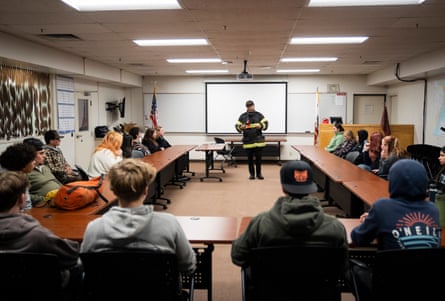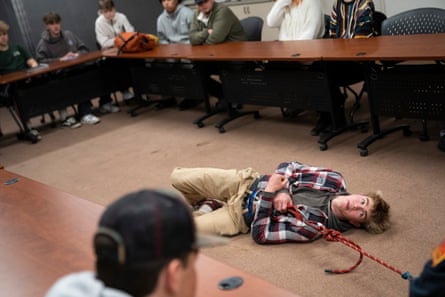Disasters like wildfires and floods are multiplying. US schools are training students to c
September 29, 2025
This story is from the Hechinger Report
Gavin Abundis watched as firefighter Adrian Chairez demonstrated how he uses pulleys and harnesses to rappel down buildings. “You’ve probably seen it in the movies where they’re going down Mission: Impossible style,” Chairez said with a laugh one day this past winter as he prepared to step off a tower. “We get to do that.”
Abundis, a then senior at Aptos high cchool in Santa Cruz county’s Pajaro Valley unified school district, has a friend whose home burned down a few years ago in a fire sparked by lightning. He said it’s pretty common to know someone who has been affected by fires in California, especially as they become more frequent and intense because of the climate crisis. That drew him to this class on fire technology, and may steer his career.
“Knowing that there’s something that I can do about it to serve my community definitely encourages me to pursue this career,” said Abundis.
Demand for the course has grown so much in recent years that the Santa Cruz county office of education, which jointly runs the class with the Watsonville fire department, doubled the number of classes offered, from two to four, this school year. “There was a time when we would go into the schools and recruit students,” said Rudy Lopez Sr, fire chief of the Watsonville department. “Now, they just sign up.”
As the climate crisis alters the environment and economies, the need is growing for jobs that help prepare for, respond to and lessen damage caused by fires, floods and other natural disasters. That’s led schools and community colleges to explore how to prepare students for careers in such fields as fire science, protecting and restoring watersheds and other ecosystems, forestry management and search and rescue. In some cases, student interest is driving the new courses – surveys show teenagers and younger adults are more environmentally conscious than older people and more likely to support action on the climate crisis.

Kate Kreamer, executive director of Advance CTE, a non-profit that supports state leaders who oversee career and technical education programs, said more school districts are offering climate-related CTE courses, but it’s challenging to find statistics because the issue is so politicized and because what the classes are called differs by school, district and state. One example of that growth: A “resiliency careers in forestry” program, which trains people as foresters, fire program managers, and log truck drivers at five California community colleges, enrolling about 700 students compared with 37 when it launched three years ago, according to the Foundation for California Community Colleges.
Students in Santa Cruz’s year-long fire science course say they love that it’s so hands-on. They practice putting on and taking off more than 70lbs of equipment in under 90 seconds, watch water cannon blast from the top of fire engines and get a chance to hold “attack lines”, 200ft-long water hoses. They also learn about the specialized vocabulary of firefighting, the range of jobs available and the certifications that are required. The course helps expose students to careers in firefighting, which is facing a significant shortage of people to fill jobs in California and some other regions of the country. In the state, entry-level jobs pay between roughly $50,000 and $100,000 per year, according to the statewide group California Professional Firefighters.
Charlotte Morgan, a soft-spoken then senior from Aptos in the Watsonville class, said she wanted to take this course specifically because of her interest in the climate crisis: “Growing up in Santa Cruz, we spend so much time outside and we care so much about it, and I want to protect that.”
Her friend Bellamy Breen said she felt the same way, though she’s interested in working on water conservation issues. “With climate change there’s more droughts, there’s more saltwater intrusion, and with all the agriculture here, it’s very important,” she said.
Former president Joe Biden championed such initiatives as the 2021 Infrastructure Investment and Jobs Act and the 2022 Inflation Reduction Act, which invested billions of federal dollars in supporting jobs that tackle the climate crisis, including clean energy manufacturing, water infrastructure projects and wildfire prevention and preparedness efforts. Under Donald Trump, who calls climate change a hoax, there has been a swift reversal of those initiatives. In recent months, the federal government has let go of hundreds of climate scientists, halted research funding and canceled 400 grants to help communities prepare for more extreme weather events.

Yet for communities that have been hit with natural disasters, there is a demand for jobs that transcend politics, even in conservative communities where the climate crisis is sometimes dismissed as fake science.
John Gossett, president of Asheville-Buncombe Technical Community College in North Carolina, said that after Hurricane Helene devastated his region last year, college presidents in Mississippi and Louisiana who have endured catastrophic natural disasters told him to expect an enrolment drop of 40% to 50% . But Gossett said that while enrolment in several programs has remained flat, courses in fields that were highly visible during the hurricane – such as fire and rescue, EMT and paramedics and nursing – have drawn more interest from students.
Police officers played a big role during the disaster, participating in search and rescue missions and directing traffic. Gossett said the college had to double its number of basic law enforcement training cohorts from two to four this semester in response to the unexpected demand. It also reinstated a course in geomatics, or land surveying, and added a class in agri-permaculture, an approach to land management that imitates natural ecosystems in rebuilding. The college’s construction program offers additional environmentally friendly certifications, including in green buildings and solar technology.
Gossett sees a strong link between these in-demand courses and economic development of the region, even though there is no mention of climate change in course descriptions. “It’s in our mission, it’s what we do,” he said. “We’re trying to help people get to a better place in life, where they can make more money and have more options. And all of that is wrapped around workforce development.”
South-eastern Kentucky has also been hit recently by disasters, including catastrophic floods in 2021, 2022 and 2025 that led to a devastating number of deaths, unsalvageable homes and mud-filled businesses and school buildings. It’s the region served by Hazard Community and Technical College, with 4,400 students across campuses in Central Appalachia. “You just can’t believe how much water there was, there was 6ft of water in one of our buildings,” recalled its president, Jennifer Lindon.

She said the college is rethinking course offerings to be more responsive to the disasters. Hazard offers an annual firefighter training, but water rescue is becoming such an important part of the job that the college is adding a swift water rescue component, focused on saving people from fast-moving floods, for first responders from across the state. Its classes in construction are changing too, to incorporate information on how to rebuild homes on higher ground to better withstand winds and floods. Because of the demand, Hazard now runs several construction courses simultaneously, and the curriculum is accelerated – what would have taken 16 weeks now takes six.
Lindon said there are waiting lists for Hazard’s heavy equipment and line worker classes, as the community clears debris and rebuilds infrastructure. The college is also designing a new course on water treatment systems, after a plant flooded, leaving several counties with no drinking water for days. Lindon said the county is building a new treatment facility, which means there will be several jobs available.
“It’s time to really sit down and think about how we plan for 10 years, 20 years, because I don’t think that these disasters are one-offs,” she said. “What we thought was a 1,000-year flood has happened in three of the last five years. So it’s a different time for sure. Most of us all really love this area. We want to stay here, so we need to figure out how to better protect it.”
Other institutions are seeing the need to reach out to students to get them interested in these careers early on. John Boyd leads Mayland Community College, about an hour drive from Asheville, North Carolina, which was devastated by Hurricane Helene.

Boyd’s community is still cleaning up from the storm, and the college has lost students as many residents moved out the area. But it hired a firefighter instructor to teach the area’s all-volunteer firefighters and work with K-12 schools to expose younger students to careers important in the region. The college is also building an environmental science center featuring exhibits for children to give them a better understanding of local environmental changes, like how physical damage during Hurricane Helene caused rivers to become permanently wider and deeper.
In this deep red area, no one mentions the climate crisis. “We’re a very, very conservative area here,” said Boyd. “We focus on what it is and what we do now, not how it got there.”
The college is also training operators of large machinery like backhoes and bulldozers. Half of the trees in one local county were downed in the storm, and other debris still needs to be cleared. “That timber in another year is going to become a massive fire hazard,” said Boyd. “For the next few years we’re going to have a lot of fuel laying on the ground.”
Kreamer, with Advance CTE, said disaster-related coursework is one piece of a bigger shift, with high schools around the country altering courses in fields as diverse as construction, HVAC, fashion technology and cooking to adapt for the climate crisis. Matt Siegelman, president of Burning Glass Institute, which analyzes labor market data, said many traditional jobs now require an understanding of green technology. Construction, for example, increasingly relies on sustainable materials, energy-efficient designs and newer construction techniques. Green jobs are growing at about 2% a year, but traditional construction jobs that require some green skills are growing much faster, he said.
Kreamer said that as demand for these roles grows, a number of challenges must still be overcome, including improving collaboration between education and industries and between community colleges and K-12 schools. “You can only do so much by reskilling,” she said. “Adults have to look at the next generation as part of that pipeline strategy,” by introducing students to career options in elementary and middle school.
In firefighting, career opportunities differ by geography, with rural areas often relying on volunteer squads and larger cities on paid workers. Concerns about the health risks facing wildfire firefighters have also been intensifying.
In California, more than 6,500 wildfires have broken out so far in 2025, putting this on pace to be one of the worst years for fires on record. In Santa Cruz, district administrators expect more than 110 students to complete the fire science program this school year, compared with 57 last year.
Students say they learn not just about fighting fires, but also about standing up for others, persevering and not getting discouraged. “It’s super-valuable life advice,” said Jack Widman, a then-senior, during last winter’s class at the Watsonville fire station. Like his classmate Gavin Abundis, Widman is considering a career in firefighting.
“Firefighting doesn’t solve climate change,” added Abundis, “but I feel I’m part of the solution.”
This story was produced by The Hechinger Report, a nonprofit, independent news organization focused on inequality and innovation in education. Sign up for the Hechinger newsletter.
Search
RECENT PRESS RELEASES
Related Post




